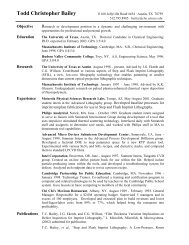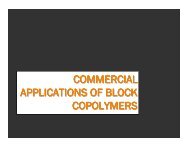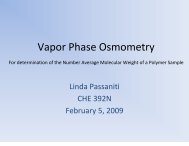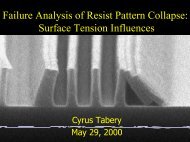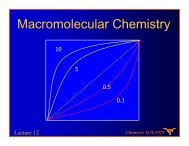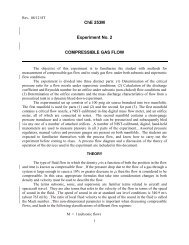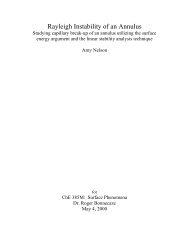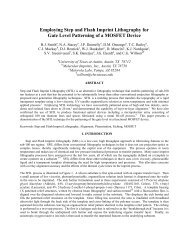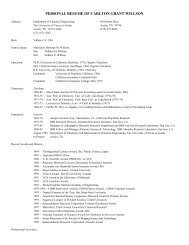Asymmetric fluid-structure dynamics in nanoscale imprint lithography
Asymmetric fluid-structure dynamics in nanoscale imprint lithography
Asymmetric fluid-structure dynamics in nanoscale imprint lithography
- No tags were found...
You also want an ePaper? Increase the reach of your titles
YUMPU automatically turns print PDFs into web optimized ePapers that Google loves.
hardware systems are for stream-to-disk or RAM buffer operations. For <strong>in</strong> situsampl<strong>in</strong>g, or <strong>in</strong> this case, when time stamps of the correspond<strong>in</strong>g encoder, forcesensor, and spectral data are required, the data cannot be streamed to the RAMbuffer for post-process<strong>in</strong>g. LabVIEW limited the sampl<strong>in</strong>g frequency. Inoptimiz<strong>in</strong>g the software for speed, there was a trade-off between speed,robustness, and memory usage. The spectrometer CCD array has 2048 pixels andthe LabVIEW software drivers provided by Ocean Optics ® output the entiredata array. If the amount of memory allocated to store this array is large, thislimits the speed at which the spectral data can be sampled. Therefore, data wascollected for up to 2 seconds. This resulted <strong>in</strong> a sampl<strong>in</strong>g frequency of 13 Hz,which is adequate to see trends <strong>in</strong> the motion profile. This sampl<strong>in</strong>g frequency isan example for this particular embodiment and is not a limitation of theprocess<strong>in</strong>g capability for <strong>in</strong> situ gap sens<strong>in</strong>g. An implementation <strong>in</strong> C/C++ orother high level language would yield vastly improved process<strong>in</strong>g speed.Figure 6.3 shows a screenshot of the current implementation <strong>in</strong>LabVIEW. Notice that the two charts, on the left of Figure 6.3, display<strong>in</strong>g anFFT of the signal are exemplary. Remov<strong>in</strong>g the periodic <strong>in</strong>formation conta<strong>in</strong>ed <strong>in</strong>the reference signal was <strong>in</strong>itially difficult s<strong>in</strong>ce measur<strong>in</strong>g reflectivity datathrough quartz was not performed <strong>in</strong> dissolution rate monitor<strong>in</strong>g. This problemwas overcome by recogniz<strong>in</strong>g that when the template is far away from thesubstrate, a reference signal can be taken because there is no <strong>in</strong>terference at largegaps. This distance still needs to be quantified, however, this is a signalprocess<strong>in</strong>g issue. Some discussion of the signal process<strong>in</strong>g issues will beprovided later <strong>in</strong> section 6.4 of this chapter.81



